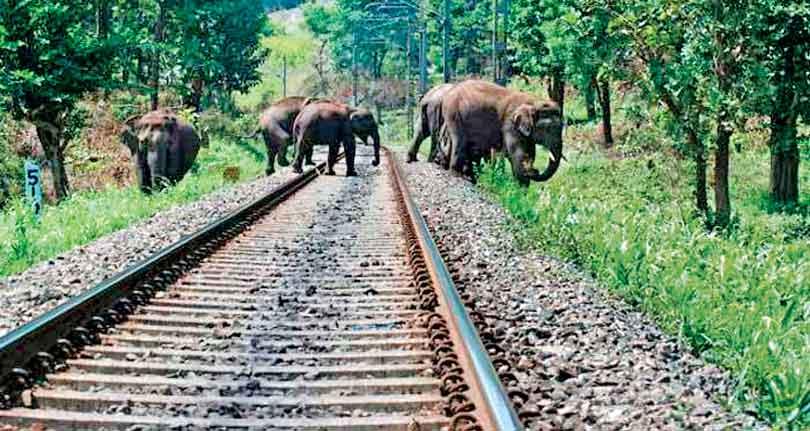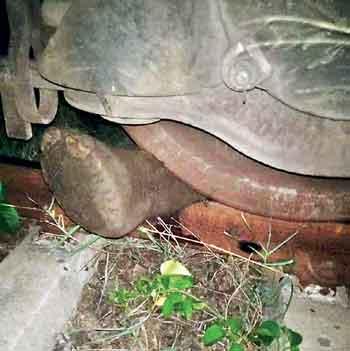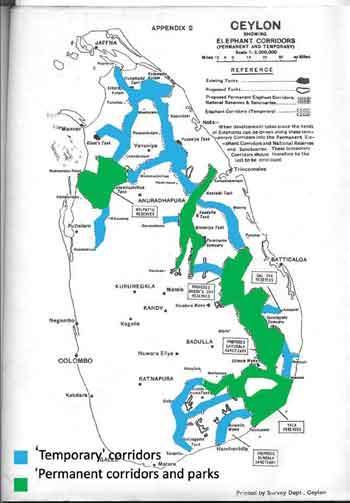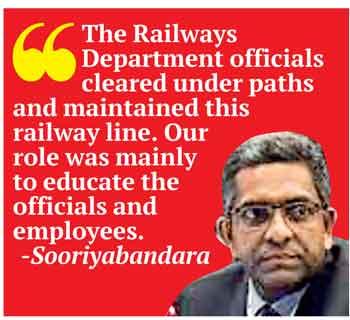Reply To:
Name - Reply Comment
Last Updated : 2024-05-07 01:51:00

Alarming spike in elephant deaths demands urgent attention
 Eleven deaths within 36 hours. That is the alarming rate at which Sri Lanka’s elephants were killed several weeks ago. On September 27, six elephants were killed in two separate train collisions – four elephants died after colliding with a night mail train travelling from Colombo to Kankesanthurai, while another female tusker and a calf succumbed to injuries after colliding with the Meenagaya Train en route from Batticaloa to Colombo. While the numbers themselves are disturbing, the fact that no action is being taken to mitigate these issues at the policy level is even more disturbing.
Eleven deaths within 36 hours. That is the alarming rate at which Sri Lanka’s elephants were killed several weeks ago. On September 27, six elephants were killed in two separate train collisions – four elephants died after colliding with a night mail train travelling from Colombo to Kankesanthurai, while another female tusker and a calf succumbed to injuries after colliding with the Meenagaya Train en route from Batticaloa to Colombo. While the numbers themselves are disturbing, the fact that no action is being taken to mitigate these issues at the policy level is even more disturbing.
Alarming statistics
 Data from the Department of Wildlife Conservation indicated that over 100 elephants had died during the first quarter of 2023. Around 67 elephants have succumbed to gunshot injuries, illegal electrocution and elephant crackers.
Data from the Department of Wildlife Conservation indicated that over 100 elephants had died during the first quarter of 2023. Around 67 elephants have succumbed to gunshot injuries, illegal electrocution and elephant crackers.
However, subject Minister Pavithra Wanniarachchi announced that over 238 elephants had been killed as of July this year and that many elephants were killed after being tortured.
The highest number of elephant deaths were reported from Anuradhapura with numbers totalling 34 as of April this year. Humans too are at the receiving end of the ever-aggravating human-elephant conflict which is a result of haphazard developmental facilities.
Human encroachment has been one of the biggest threats to elephants as people continue to build houses and other developments along elephant corridors and other environmentally sensitive areas. Even though the elephant is a protected animal under the Flora and Fauna Protection Ordinance, the culprits are seldom apprehended.
Sensitizing engine drivers, an urgent need of the hour
 One of the immediate approaches to mitigate elephant-train collisions is to sensitize engine drivers on the importance of saving a life, irrespective of whether it’s a human or an animal while on the move. Even though the Railways Department and the Department of Wildlife Conservation (DWC) have taken certain collaborative measures in the past, it now seems that more innovative approaches need to be developed to save the rest of the elephants in Sri Lanka’s forests.
One of the immediate approaches to mitigate elephant-train collisions is to sensitize engine drivers on the importance of saving a life, irrespective of whether it’s a human or an animal while on the move. Even though the Railways Department and the Department of Wildlife Conservation (DWC) have taken certain collaborative measures in the past, it now seems that more innovative approaches need to be developed to save the rest of the elephants in Sri Lanka’s forests.
In his comments, prominent elephant researcher and former director of the Department of Wildlife Conservation Dr. Sumith Pilapitiya shed light on the importance of sensitizing engine drivers and conserving elephant home ranges.
Excerpts:
What are the reasons for the increase in deaths of elephants on railway tracks?
The drought this year was very severe. During such times, elephants move around more than they would do normally in search of food and water. Increased movement means that they come into more contact with humans and human infrastructure, such as railway tracks which they have to cross. Knowing this, the Sri Lanka Railways should be sensitizing their drivers to be more aware of the risk of increased elephant crossings. If the engine drivers were more sensitized to this, they may be more careful and would be able to reduce elephant/train collisions.
Are there speed limits introduced in such highly sensitive areas?
 Yes, speed limits have been posted in areas of frequent elephant crossings.
Yes, speed limits have been posted in areas of frequent elephant crossings.
Unfortunately, adherence to speed limits is ad hoc at best, because nobody is monitoring the speed of trains.
A former engine driver from Sri Lanka Railways told me that if the train is going around 40 km/h and knocks down an elephant, the elephant gets mangled under the train whereas if the train speed exceeds 50 km/h, the elephant gets thrown forward or sideways as a result of the impact of the accident.
If what this engine driver told me is correct, then Sri Lanka Railways could figure out the speed of travel and take disciplinary action accordingly.
There is a debate on conserving elephant home ranges instead of merely looking at elephant corridors. Could this be a better approach to prevent elephant deaths?
Elephants in Sri Lanka have home ranges. Based on radio collaring data, we see that the elephants in Sri Lanka do not make long-distance migrations. But they have to have freedom of movement within their home ranges. Movement paths and connectivity within their home range should be ensured. So conserving their home ranges, including ensuring that they have connectivity within their home range is essential.
However, their home range could include habitat on both sides of a railway line. If so, they will continue to cross the railway line and the risk of train accidents will be present.
Shouldn’t the Railways and Wildlife Departments work together to mitigate this issue?
 Yes, both DWC and SLR should work together to minimize train/elephant accidents. Awareness and sensitization of the driver are essential. I believe that there has been some collaboration between the two agencies, but more is needed.
Yes, both DWC and SLR should work together to minimize train/elephant accidents. Awareness and sensitization of the driver are essential. I believe that there has been some collaboration between the two agencies, but more is needed.
There is a 10-meter railway reservation on either side of the track. If this reservation is cleared of vegetation, visibility for both the engine driver and the elephants will be much better than it is today. This is a simple measure that they could try immediately.
Investigate the link between train movements and elephant behaviours - Gunasinghe
In response to the spike in elephant-train collisions, Sri Lanka Railways General Manager W. A. D. S Gunasinghe reiterated the need to collaborate with the DWC, Forest Department, and the people in the areas and other stakeholders in mitigating this issue.
“There were attempts to introduce different kinds of technologies and novel approaches, but these attempts didn’t get implemented,” Gunasinghe said in an interview with the Daily Mirror.
He said that engine drivers have been trained to face such situations and suspects that there is a possible link between train movements and the behaviour of elephants.
“It could be that elephants collide with trains if a train deviates from its usual schedule. But this has to be investigated,” he underscored.
Existing collaborative approaches need to be strengthened – Sooriyabandara
 Collaborative approaches such as clearing shrubs up to 30 meters from either side of the railway tracks, putting up signboards at elephant crossings, enforcing train speed limits, building overpasses and underpasses for elephant crossings and removal of obstructions at elephant crossings have been carried out for several years.
Collaborative approaches such as clearing shrubs up to 30 meters from either side of the railway tracks, putting up signboards at elephant crossings, enforcing train speed limits, building overpasses and underpasses for elephant crossings and removal of obstructions at elephant crossings have been carried out for several years.
“These approaches need to be further strengthened rather than introducing more approaches,” said DWC Director General M. G. C Sooriyabandara.
“We have conducted awareness programs for engine drivers as well. The Northern railway line was completely renovated but before that, there was a prescription system installed for every ½ km from Kurunegala onwards.
“The Railways Department officials cleared under paths and maintained this railway line. Our role was mainly to educate the officials and employees.”
When asked about finances required to further strengthen these approaches Sooriyabandara said that the officials used financial provisions allocated to them and that block amounts were not allocated for these activities.
What is left for people is to weep as they keep a close watch on what the authorities would possibly do to minimize elephant-train collisions.
It is in this threatened backdrop that jumbos such as Seetha – an elephant that was recently shot at by wildlife officials, continue to receive treatments as she battles for life.
Suspects arrested for Seetha’s incident were released the same day. Then there are unidentified elephants inside Sri Lanka’s jungles who limp through forest patches, donning swollen wounds, and decapitated trunks, some blinded, some deaf, as a result of brutal anthropogenic activities.
Over 400 elephants were killed in 2022 while over 140 people succumbed to injuries as part of the human-elephant conflict. These figures have elevated Sri Lanka as a country, or perhaps the only country with the highest number of elephant deaths. And the future of elephants in Sri Lanka, certainly remains grim.
Tissa Fernando Thursday, 05 October 2023 06:50 PM
There are too many elephants in Sri Lanka now. Definitely there is an issue for the land.
aswin welikala Friday, 06 October 2023 01:01 AM
You are a negative thinking person. So keep to your self
aswin welikala Friday, 06 October 2023 01:02 AM
They should build overhead bridges for the elephants to pass as other countries do.
Ceylonese Friday, 06 October 2023 07:27 AM
It is so unfortunate that these majestic elephants that once roamed freely the length and breadth of the country long before man even set foot on this part of the planet earth are being denied their freedom and killed by selfish human beings. If these innocent animals spoke the same language then man woudn't have his own way.
Lokubanda Tillakaratne Friday, 06 October 2023 09:14 AM
Have a transponder system on board each railway engine like what you find in airplanes to know each other's location. Then attach one transponder to a matriach in each elephant herd. Elephants have distinct family structure and we can begin attaching a transponder in each herd. The two transponder (transmitter and responder) will know each other's location and the train engineer can slow down when alerted by the herd's transponder. This may cost money, but not as costly as supiri vehicles we import for the 225.
melville perera Friday, 06 October 2023 09:24 AM
considering the cost of repairs and compensation digging out a wide tunnel under the rail track would be workable. There is plenty of steel waste in every railway yard , When completed to train the elephants to use it, it would be a good idea to daily dump a rail wagon load of waste vegetables sans plastics at that point freely available at manning market close to the rail yard. Labour could recruited by the railway. There are enough of idlers in the country
Lawry Friday, 06 October 2023 11:15 AM
Even this article does not talk of a constructive approach, rather it talks of future study. My smart phone GPS can tell me the traffic in the city roads. So why not use technology now and think of strategy later. Why not send a drone ahead of the train. Can it be programmed to give feed back to the train. Can the ministry conduct a competition university students to come up with practical intelligent solutions. A obe million rupee reward can be advertised. Railways put you thinking cap on.
Kapila Ranawaka Friday, 06 October 2023 09:30 PM
No one wants to mitigate this unfortunate situation. Every one we called experts are the dependents of HEC and the REC. They use this pathetic situation to fulfill their earnings, and that's the bottom line.
‘The Lansi Burgher Gent’ Saturday, 07 October 2023 12:33 PM
What a sad, sad, sickening country this is. A cursed land indeed. No wonder we are rife with problems after problems. Such innocent animal life being taken on a day to day basis, due to sheer ignorance and stupidity of all concerned. ‘Pathetic’ isn’t the word. Absolutely scant regard for elephants and dogs here. Shameful place.
Man Sunday, 08 October 2023 06:52 AM
The whole issue of the need of proper elephant corridors with bridges where applicable places without deforestation for solar, sugar, etc., as it is the root cause for elephant deaths of over 400, per annum, in SL.
Jinasena Marambe Saturday, 14 October 2023 04:10 AM
The truth will never come out until we kick all these 225 and unelected people out and put all in jail! Then SL can solve this and many other unsolved issues!

Add comment
Comments will be edited (grammar, spelling and slang) and authorized at the discretion of Daily Mirror online. The website also has the right not to publish selected comments.
Reply To:
Name - Reply Comment
US authorities are currently reviewing the manifest of every cargo aboard MV
On March 26, a couple arriving from Thailand was arrested with 88 live animal
According to villagers from Naula-Moragolla out of 105 families 80 can afford
Is the situation in Sri Lanka so grim that locals harbour hope that they coul
4 hours ago - 0 - 215